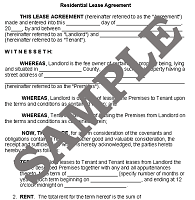What Makes a Great Landlording Lease Agreement?
Posted on May 10, 2012 by Landlords – especially new landlords – often wonder (and worry) whether they are using an effective lease agreement. Truth is, most landlords use terrible agreements.
Landlords – especially new landlords – often wonder (and worry) whether they are using an effective lease agreement. Truth is, most landlords use terrible agreements.
When we bought our first rental property in 1995, we didn’t know anything about managing rental property or tenants. Needless to say, we also knew nothing about lease agreements. The realtor we used gave us a lease written by the Georgia Association of Realtors (GAR). We thought it was the greatest document ever written!
As our experience quickly grew – and after attending several landlording seminars – we realized the GAR lease was T-E-R-R-I-B-L-E! Why? First, because it’s written in legalese, almost no one – including landlords and tenants – understands it. Lesson one: A lease needs to be understandable… which means it should be written in plain English, not Latin.
Lesson two: The realtor told me the GAR lease was written with the intent of being fair to both the landlord and tenant. Nothing personal, but since it was our house that we had bought and were paying for, Kim and I weren’t interested in being fair – we wanted an agreement that was ironclad and protected our assets.
We quickly switched to a pro-landlord lease agreement. It worked great!
Over time, as we continued to learn hard-knocked lessons from our tenants, we kept adding new sections to the lease, causing it to get longer and longer. In 2006, while going through some old paperwork, I ran across that original pro-landlord lease I had first used in 1997. It looked nothing like what I was using in 2006. The biggest difference was length. The old lease was eight-pages long, while the 2006 lease was a whopping 14 pages! Boy, had I gotten carried away.
The reality was this: As of 2006, I had only taken two tenants to court. In other words, I had learned that the secret to working through landlord-tenant problems was to sit at the tenant’s kitchen table and find a win-win solution that didn’t involve attorneys and judges.
With this new realization, I rewrote my lease and cut out a lot of the yada yada, shrinking it from 14 pages down to seven pages. It was now much more understandable and a lot easier to read. This takes us back to lesson one: A lease needs to be understandable to the average person.
Today, I’m a much wiser landlord than I was when I started. I’ve learned that simple is better than complex. After all, why say something in a thousand words when ten will do? With this in mind, I’ve begun another rewrite of my lease, with the goal of whittling it down to two pages.
Here are the basics: Tenant agrees to 1) Take care of the property; 2) Be comfortable to work with; 3) Pay his rent on time. Landlord agrees to 1) Fix things when they break; 2) Be comfortable to work with; 3) Pay the mortgage on time. It doesn’t get simpler than that.
Hope this helps you to be a better, more effective landlord.
 Bill & Kim Cook are a husband and wife real estate investing team. They live in Adairsville, Georgia and have been investing in real estate since 1995. They specialize in buying single-family homes, mobile homes and mobile home parks. They also run North Georgia REIA and teach folks how to successfully invest in real estate.
Bill & Kim Cook are a husband and wife real estate investing team. They live in Adairsville, Georgia and have been investing in real estate since 1995. They specialize in buying single-family homes, mobile homes and mobile home parks. They also run North Georgia REIA and teach folks how to successfully invest in real estate.
Do you share this lease or sell it? If so, sounds like I could use one! I need to rent out an underwater condo. :(
Nathan, you can contact Bill about the contract at http://reioutpost.com. If you have an underwater condo you would like help leasing (instead of doing it yourself), let us know. Thanks.